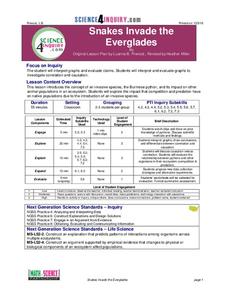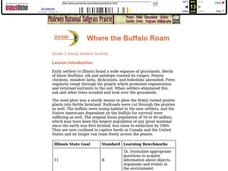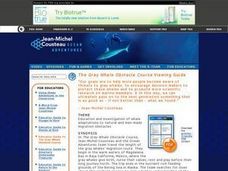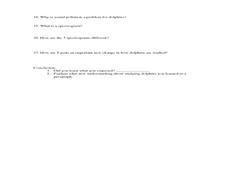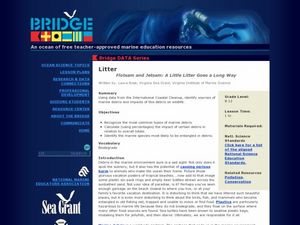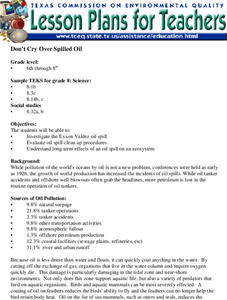Curated OER
Mammals of Fields, Meadows, and Hedgerows
In this mammals instructional activity, students research the internet to find information and answer short answer questions about mammals of fields, meadows, and hedgerows. Students complete 12 questions.
Curated OER
The Five Classes of Vertebrates
What a terrific lesson plan! Learners discuss the animal kingdom, and classify them as vertebrates and invertebrates. They also identify them as fish, amphibians, reptiles, birds, and mammals. There is even a taxonomic breakdown of...
Global Change
Impact of a Changing Climate on the Pacific Walrus
How many of us can say they've seen a Pacific walrus? Not many and one of the reasons is the impact of climate change on their aquatic environment. Children get to think about the food web of the Bering Sea by creating an actual web with...
Curated OER
Mammals
In this mammals worksheet, students click on the links in the questions about mammals to find the answers to the questions and then come back and answer the questions. Students answer 8 questions total.
Science 4 Inquiry
Snakes in the Everglades
The Burmese python is on the loose ... and he's hungry! Illustrate the differences between causative and correlative relationships through an inquiry instructional activity. Pupils examine several sources of information to determine if...
Curated OER
Pleistocene Mammals
Young scholars research the causes of the extinction of Pleistocene mammals. In this Pleistocene mammals lesson, students read essays to understand the Pleistocene epoch. Young scholars write an essay about the personal impact of...
PBS
Population Simulation with M&M's
Math and M&Ms® go great together when introducing a modeling activity. Allow your learners to simulate population growth and decay of fish in a pond and share their reasoning for the change in fish. With such an impact we have on our...
Curated OER
Biodiversity Debate - Stream Side Science
Role play community members who are both for and against the construction of a dam. Research the pros and cons and then hold a classroom debate. This activity ideally follows a series of stream studies, links to which are included. Use...
Curated OER
Big Arky, A Real Arkansas Monster
Middle schoolers examine the world of the Arkansas alligator and topics that are related to wetland environments. They pay attention to the relationship between geography, climate, environment, and the animals who live there. A role-play...
Curated OER
Caught in a Net
Young scholars read and discuss the bycatch of the sea and the economic impact of taking bycatch away. In this bycatch lesson plan, students discuss the rights of fisherman and observe pictures of sea animals.
Curated OER
Where the Buffalo Roam
Second graders explore what life in the Chicago area was like hundreds of years ago. They discuss how settlers impacted the environment, and why there are no longer herds of buffalo in the Chicago area today. They read an article and...
Curated OER
Wild Dog Urine
Learners investigate biology by researching wild animals. In this animal extinction lesson, students research African wild dogs and discuss the impact of the environment on their survival. Learners read and analyze an article titled...
Alliance Theater
The Jungle Book Post-Show STEAM Lesson
An ecosystem is really just the flow of energy through many different living organisms. A study of Rudyard Kipling's The Jungle Book leads to an environmental science activity in which learners study how various factors can affect...
Curated OER
The Gray Whale Obstacle Course Viewing Guide
Students complete a worksheet while watching a film about whales. They examine the human impact on whale migration and identify adaptations the whale has acquired in able to survive. They discover how global warming has effected the...
Curated OER
Oil Spill Lesson Plans
With the recent oil spill in the Gulf of Mexico, now is a great time to educate students on issues related to oil.
Curated OER
Understanding How Researchers Study Dolphins
Students examine how researchers study dolphins and whales. In this scientific research lesson, students complete a Web-based interactive lesson focused on showing how researchers study aquatic mammals. A worksheet and web resources are...
Curated OER
The Environments of Big Sur:Which Do We Protect?
Students examine the California environments. In this environmental lesson, students examine the various ecosystems of California, creating a presentation on how these environments impact Big Sur. They write a paper defending their point...
Curated OER
Key Figures of the 1899 Harriman Alaska Expedition
Students gain general knowledge of the goals, route, participants, and significance of the 1899 Harriman Expedition. They link names of glaciers, fiords, mountains, flora and fauna with names of the 1899 Harriman Expedition...
Curated OER
LitterFlotsam and Jetsam: A Little Litter Goes a Long Way
Students explore the concept of environmental stewardship. In this science lesson, students investigate data from the International Coastal Cleanup, identify sources of marine debris, and discover the impacts of this debris on wildlife.
Curated OER
NS 6: Monerans, Viruses
Students compare the structures and functions of viruses and bacteria relating their impact on other organisms. They review the main vertebrate groups. Students are describing the characteristics of the main group of vertebrates: ...
Curated OER
Great Blobs of Jelly!
Learners explain how zoo-plankton have an impact on the global process. In this ocean zoo-plankton lesson plan students calculate carbon flux and plankton densities.
Curated OER
Milk: A Practical Application
Students examine the impact of the physical and chemical properties of milk and its use as an important food.
Curated OER
Don't Cry Over Spilled Oil
Students study the Exxon Valdez Oil Spill while evaluating oil spill clean up activities. They discover the long term impact can have on an ecosystem by completing this experiment.
Curated OER
How Old Is Old?
Young scholars explore longevity in the United States and the impact of one living longer. Statistics are used to identify life expectancy of an individual from his or her birth. Gender differences are investigated.




